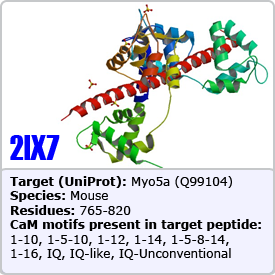Calmodulin (CaM) is a ubiquitous intracellular calcium sensor that directly binds to and modulates a wide variety of enzymes, ion channels, and membrane transport proteins. CaM communicates changes in intracellular calcium levels by binding to consensus sites known as CaM-binding motifs in both the presence and absence of calcium. Canonical CaM-binding motifs are defined by the varied spacing of hydrophobic anchors [FILVWY]; thus, identifying potential binding sites by sequence gazing is challenging. A description of the different canonical CaM binding motifs can be found here.
This site uses a script to identify all the canonical (14 currently) CaM target sites from an entered sequence and predicts CaM binding sites based on the density of canonical CaM binding sites within a given sequence. A charge discriminator reduces the misidentification of hydrophobic stretches (e.g. transmembrane domains) as potential CaM binding sites. The algorithm and meta-analysis were published in J Gen Physiol. (2014) 144, 105-14
Calmodulin (CaM) is a ubiquitous intracellular calcium sensor that directly binds to and modulates a wide variety of enzymes, ion channels, and membrane transport proteins. CaM communicates changes in intracellular calcium levels by binding to consensus sites known as CaM-binding motifs in both the presence and absence of calcium. Canonical CaM-binding motifs are defined by the varied spacing of hydrophobic anchors [FILVWY]; thus, identifying potential binding sites by sequence gazing is challenging. A description of the different canonical CaM binding motifs can be found here.
This site uses a script to identify all the canonical (14 currently) CaM target sites from an entered sequence and predicts CaM binding sites based on the density of canonical CaM binding sites within a given sequence. A charge discriminator reduces the misidentification of hydrophobic stretches (e.g. transmembrane domains) as potential CaM binding sites. The algorithm and meta-analysis were published in J Gen Physiol. (2014) 144, 105-14.

The Sequence Search allows you to enter a protein sequence to find all of the canonical CaM target sites. In addition, it predicts CaM binding sites based on the number of overlapping canonical CaM motifs. A sample output for the CaV1.2 Pre-IQ and IQ regions can be viewed by clicking here. Text files containing the "wiggle file" and list of CaM binding motifs can be downloaded after the search. Below describes each input box or parameter.
| Enter Query Sequence: | Type or paste the sequence to be searched. Most non-amino acid chacters will be stripped and the sequence concatenated. |
| Sequence Name: | Name of protein sequence (optional) |
| List Motifs By: | Sorts the output list by either the type of motif (e.g. 1-10, 1-12, 1-14, 1-16, IQ, etc.) or by residue number. |
| Starting Residue: | Allows the protein sequence to start at a number other than 1. |
